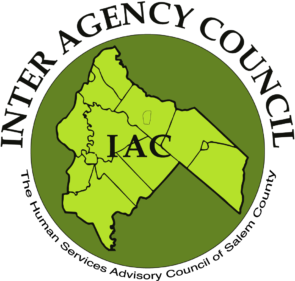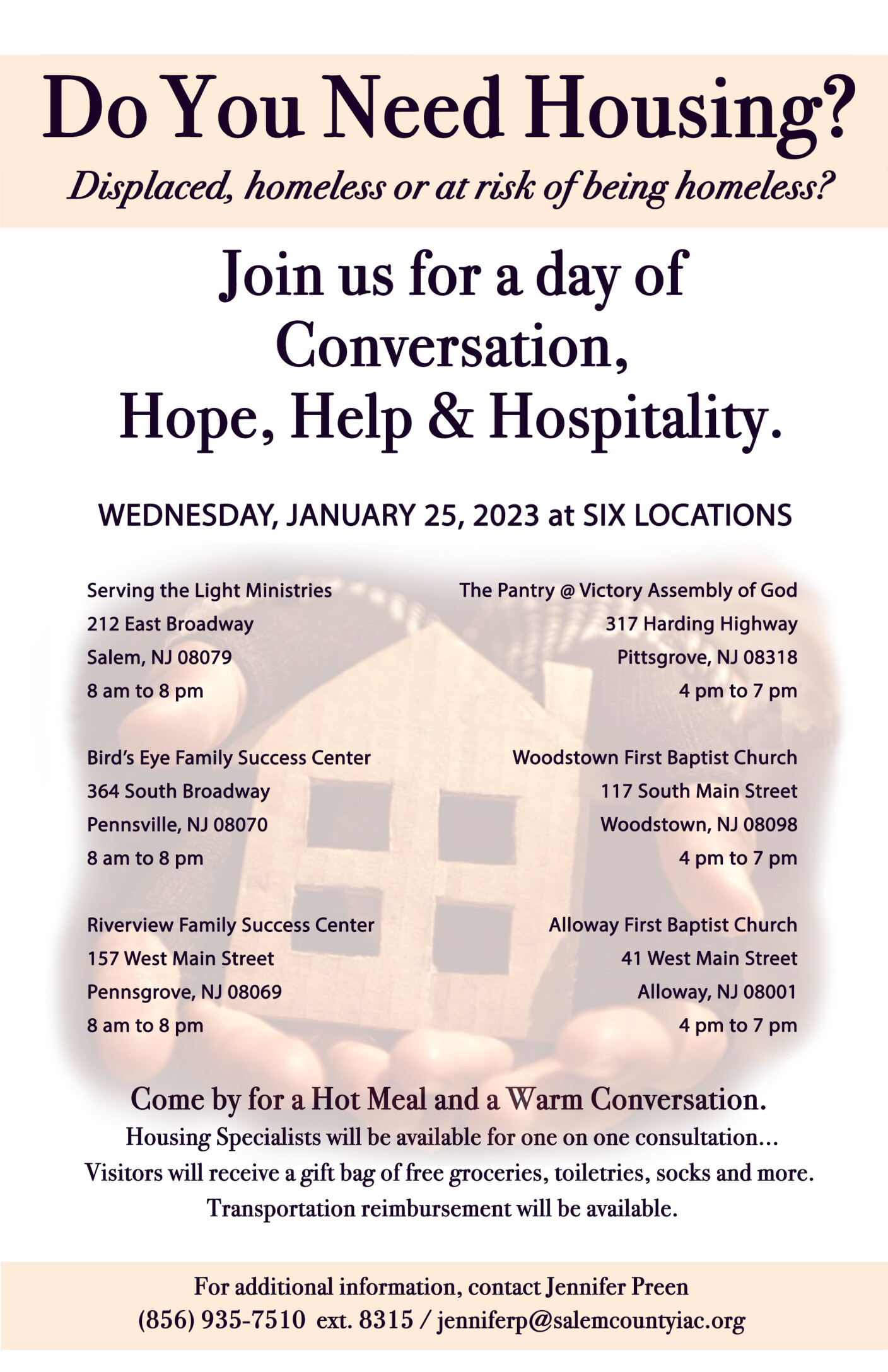Initiatives
LEASED APARTMENTS PROGRAM
IAC leases private apartment units to offer temporary residency, stabilization, and supportive services to Salem County individuals and families experiencing homelessness. In the safety of stable housing, alongside supportive case-management services, participants will identify, secure, and achieve their goals for permanent housing and transition to the permanent housing solution.
The IAC Team is excited and privileged to offer this program. The program is newly launched as of October 2023. At this early start, we have a very limited number of units available. We are working hard to acquire more units. If you are a landlord interested in leasing with us, please contact the IAC Housing Programs Coordinator. Additional program information for Continuum of Care members, service providers, community-based sites, potential participants, and interested persons is included in the FAQs below.
No, this is not an emergency shelter program. If in need of emergency housing, please contact Salem County Board of Social Services during normal business hours at 856-299-7200 and dial NJ 2-1-1 after business hours
No, this is not a rental assistance program. Participants in this program move into apartment units for which IAC holds the leases. The participants’ stay in the units is temporary, expected to last no more than three months for a period of stabilization and transition into permanent housing. A list of rental assistance programs available to Salem County residents should be up to date on NJ211.org
Category One: Literally Homeless
Individual or family who lacks a fixed, regular, and adequate nighttime residence, meaning:
(i) Has a primary nighttime residence that is a public or private place not meant for human habitation;
(ii) Is living in a publicly or privately operated shelter designated to provide temporary living arrangements (including congregate shelters, transitional housing, and hotels/motels paid for by charitable organizations or by federal, state and local gov programs); or
(iii) Is exiting an institution where (s)he has resided for 90 days or less and who resided in an emergency shelter or place not meant for human habitation immediately before entering that institution
Category Four: Fleeing/Attempting to Flee Domestic Violence
Note: All households identifying as Category Four will be connected with Salem County Women’s Services for safe planning and shelter.
(4) Any individual or family who: (i) Is fleeing, or is attempting to flee, domestic violence; (ii) Has no other residence; and (iii) Lacks the resources or support networks to obtain other permanent housing
- Complete in-person application and interview process
- Work with Coordinator to complete documentation required for enrollment
- Temporary residency in apartments must comply with terms outlined in Occupancy Agreement
- Coordinator will work with participants to develop personalized action plan, goals, and benchmarks for transitioning to permanent housing
- Coordinator will provide a detailed program orientation during enrollment
- No income requirements
- Must meet federal definitions of homelessness
- Salem County resident
- Due to volume of need in Salem County and limited program capacity, there may be a waiting list
IAC will publicize open screening and referral periods. Open periods when referrals are accepted and screening is conducted, currently are held for one-week timeframes, when there is room on the program waitlist. Screenings determine eligibility to to be added to the waitlist. When units are expected to be available within 30 days, households from the waitlist are invited to apply and interview.
During an open screening and referral period, a Screening and Referral form dated with the acceptance period is dispersed to the Salem County community of homelessness, emergency, and community service providers. This means any homeless individual or family seeking assistance from or enrolled with any provider will be informed of the opportunity to be screened. A poster is also hung at the Flying J Truck Stop. Local law enforcement and emergency response entities are specifically notified. McKinney Vento liaisons in each school district for students experiencing homelessness and daycare center contacts are notified.
Persons may call IAC to be screened over the phone or may complete a Screening and Referral form themselves and submit through several ways detailed on the form. A case-worker, loved one, or any representative may also complete a Screening and Referral form and submit on a household’s behalf. All forms submitted during open periods will be reviewed and responded to.
Wonderful! Please contact our Housing Programs Coordinator at [email protected] or 856-935-7510 ext 8318
The expected length of stay is three months
A flyer with a brief description of the program and FAQs is available by clicking the green button below that reads Leased Apartments FAQS Flyer
No. This program cannot accept inquiries, referrals, and applications at all times. This program cannot conduct screening at all times. There are specific openings when referrals can be made, screening is conducts, and applications are conducted. Open Screening and Referral periods are held and publicized when there is room on the program waitlist. Open Screening and Referral periods are typically one week in length. Screenings determine eligibility to to be added to the waitlist. When units are expected to be available within 30 days, households from the waitlist are invited to apply and interview.
During an open screening and referral period, a Screening and Referral form dated with the acceptance period is dispersed to the Salem County community of homelessness, emergency, and community service providers. This means any homeless individual or family seeking assistance from or enrolled with any provider will be informed of the opportunity to be screened. A poster is also hung at the Flying J Truck Stop. Local law enforcement and emergency response entities are specifically notified. McKinney Vento liaisons in each school district for students experiencing homelessness and daycare center contacts are notified.
Persons may call IAC to be screened over the phone or may complete a Screening and Referral form themselves and submit through several ways detailed on the form. A case-worker, loved one, or any representative may also complete a Screening and Referral form and submit on a household’s behalf. All forms submitted during open periods will be reviewed and responded to.
POINT-IN-TIME COUNT, ANNUAL WINTER OUTREACH TO THE HOMELESS
Findings from 2023 PIT Count
- On the night of January 24, 2023, a total of 52 households, including 67 persons, were experiencing homelessness in Salem County according to the 2023 Point-In-Time Count. Of the 67 total homeless persons, 54 were unsheltered. The remaining 13 persons were sheltered either at the Salem County Women’s Services (SCWS) shelter or in hotel/motels paid by the Salem County Board of Social Services. The 54 unsheltered persons represent 80.6% of the total 67 persons reported as homeless on the night of January 24, 2023.
- Of the 67 homeless persons counted, 36% reported a disability. Of the disabilities reported, mental health issues was most frequent (75%), followed by substance abuse disorder (62.5%), chronic health condition (13.2%), physical disability (8.8%), and developmental disability (6.6%).
- When asked to share the factors that contributed to, or caused, their homelessness, more households attributed their homelessness to loss or reduction of job income (11 households, 17.5%) than any other cause, followed by household breakup/death in household (15.9%).
- When households were asked ‘what issues have you encountered when trying to get access to services?’ more said lack of transportation than any other type of barrier (18 households). The top reported barriers for those residing in unsheltered locations were lack of transportation (17 households), followed by having no ID/documents and no physical mailing address (10 households, each).

